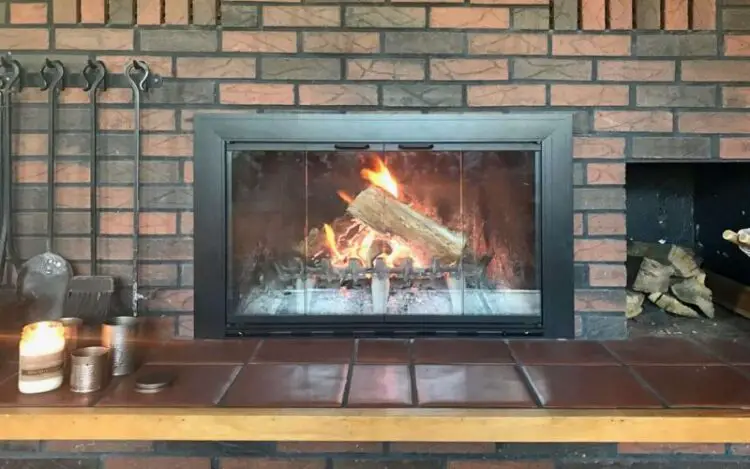Many wood burning fires without glass doors can function efficiently. Studies have shown that glass doors on a fireplace may substantially limit the heat from a fire in the room but also save heat in a home while the fireplace is in use.
This article will provide some helpful knowledge about wood burning fireplace glass doors so that you have a better grasp of their main characteristics before buying or installing one in your home.
Wood Burning Fireplace Glass Doors: What Is It? Why Do You Need One?
What Is The Purpose Of A Fireplace Glass Door?
Why have glass doors on fireplaces? The advantages of having glass doors on a fireplace are:
- Prevent warm air from sucking into the chimney from the chamber.
- Give your fireplace a completed look.
- Help maintain the heat in the house when there is no fireplace.
- Help reduce heat loss if a damper cannot be closed down after a fire for longer periods because of continuing burner gas emissions.
- Help cover the mess after a fire in the fireplace.
- Give the flames behind closed doors a nice view.
- Help enhance fire safety for young children and animals.
- Avoid spitting hot burrs and ash in the room.
- Help the chimney fit into the interior decor.
- Prevent the spread of ashes throughout the room by animals.
- Substitute a fireplace screen.
- Reduce the expense of heating.
- Reduce downdrafts in strong winds to any issues.
Do You Need Fireplaces With Glass Doors?
The fireplace can waste up to 80 percent of a fire’s heat rather than heat a space. The fireplace is wood burning.
Applications such as wood burning ovens overcome this problem by providing a screened environment for timber to burn and increasing efficiency by up to 80 percent instead of 20 percent for wood burning fireplaces.
Glass doors can or may not have beneficial effects on heat production during a fire depending on the size, form, and structure of both the fireplace and chimney.
Typically, a wood-burning chimney offers greater heat near the fire, but it may absorb enormous quantities of air from any area up the fireplace. This might lead to a net heat loss in a house.
With glass doors in a fireplace, a chimney can minimize the air loss when it is closed, provided that the doors include air blocks in the surroundings and therefore prevent warm air from leaving a residence.
Glass fireplace doors, on the other hand, might block airflow into a fire to such an extent that it continues to ignite. A poorly combustible fire can also cause more smoke, meaning that creosote in the chimney might accumulate substantially and be kept cleaned more frequently.
In addition, over time, glass doors can blacken and decrease fire visibility.
We have fireplaces for wood fires in our living and kitchen area, and there are no doors on either fireplace. Also, we do not think they ever had doors on the fireplaces. Although we don’t have glass doors in our fireplaces, we have never had difficulties with a fire.
How Can Fireplace Glass Doors Safeguard My House And Family?
The possibility of damage to people concerned and the danger of damage to your house is limited by fireplace glass doors. When most people think of the hazards of a fireplace they generally think of the worst situation, which is a raging home fire because of inadequate chimney care, creosote building, etc. But too frequently, the less obvious dangers of heating your house with a fireplace are neglected and might lead to devastation.
Glass fireplace doors significantly minimize the risks of chips or logs coming down from the fireplace that can harm tile or wood flooring, ruin carpets, melt linoleum or even roll into anyone near the fireplace.
Sparks and cinders can be floated and popped from the fireplace without glass doors on the furnace and landing on garments, furniture, or other items, which can considerably harm the property surrounding the fireplace.
How To Set Up Fireplace Glass Doors
- Join the door on lintel clamps
- Change the fasteners
- Screw holes mark
- Drill hole for plumbing.
- Insert plumbs to screws
- insulate doors
- Display the door to the floor firebox
- Lintel door clamp
Tips For The Correct Use Of A Fireplace Door
- The doors of the fireplace must stay completely open when there is an active fire. Only if the fire died down to a coal bunk may doors be closed entirely.
- The doors must be fully open at all times, whether utilizing gas logs, fire glass or contemporary gas media.
- Some doors for brickwork can be jammed for an exceptionally tight seal for wood-burning stoves.
- Tints on your doors might decrease your visibility by ashes or soot/smoke.
- Patinas and discoloration should be cleaned periodically for doors with glossy or polished surfaces (brass, chrome, polished copper). Check for the proper cleaning procedure with the dealer or manufacturer.
- Certain substances will remove the finish when combined with heat.
- During the burning season, clean the glass monthly, but if you burn a lot of wood, clean it every week. For wood burners, this is particularly crucial. The amount of elbow grease needed is reduced, and the coatings on the glass are protected against wear and strain.
Conclusion (Wood Burning Fireplace Glass Doors)
All in all, adding wood burning fireplace glass doors will increase your fireplace safety and efficiency. They also provide a cozy room with decorative appeal.
The esthetic flame display, which adds glass doors in a wood burning fire, is unmatched, as you can receive a complete, unblocked 360-degree view of the fire. The fireplace glass door is quite easy to maintain. If smoke leaves a film on your glass doors in the fireplace, they may be cleaned with a glass cleaner.

